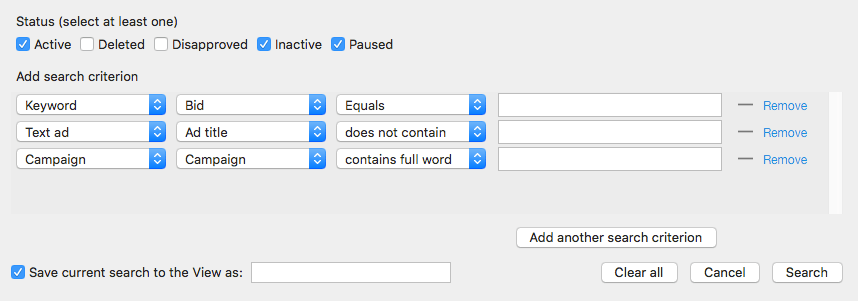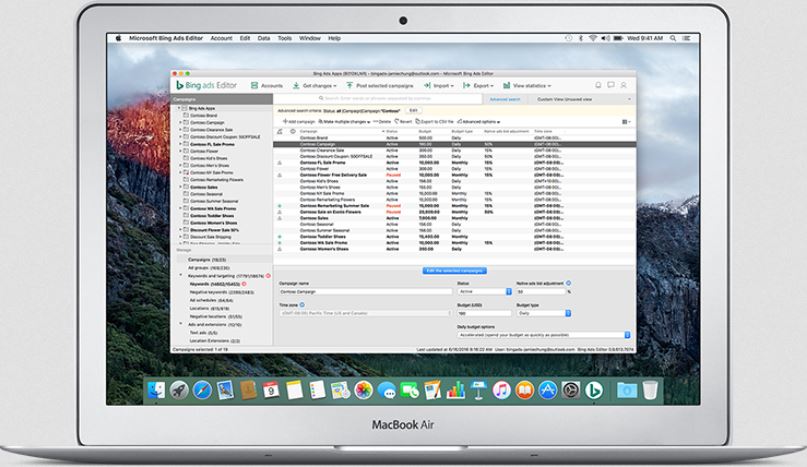- Microsoft Bing Ads Editor For Windows
- Bing Ads
- Microsoft Bing Ads Editor For Mac
- Microsoft Bing Ads Editor
- Bing Ads Editor For Mac
This app is only available on the App Store for iOS devices.
Bing Ads helps you stay on top of your advertising campaigns while you're on the go. Keep your finger on the pulse of your accounts all from your smartphone or tablet. To get started today, download Visual Studio for Mac and set it as the default editor in Unity. Visual Studio Community for Mac is free to use for students, open-source and individual developers, as well as small teams. Mar 02, 2017 Bing Ads Editor for Mac is now available globally, following the open beta of Bing Ads Editor for Mac that launched last summer. “Bing Ads already provides solutions to manage your accounts from various channels: Bing Ads online, the Bing Ads API, Bing Ads Editor for Windows and the Bing Ads app for iOS and Android,” writes Prince Bajracharya of Bing Ads Engineering.
Description
Microsoft Ads helps you stay on top of your advertising campaigns while you're on the go. Keep your finger on the pulse of your accounts all from your smartphone or tablet.
• Monitor your favorite campaigns and get performance data on the go
• Quickly make changes to update your status, budgets and bids
• Get notified to know when your automatic rules have ran or credit cards are about to expire
• Visualize how your account or ads are performing and compare metrics side by side
• Get in touch with Bing Ads support whenever you need
help
What’s New
Ratings and Reviews

BING IS WINNING ME BACK!
I used to use bing to advertise a while back but discontinued because it was too hard to get the price range I needed. However, that no longer is the case. I even called and received the help i needed to get my campaigns set right. I use the app almost daily to check out how my adds are doing as well. I plan to keep advertising with bing for quite a while.
I freakin love the app.
.jpg)
Bingads, you are amazing. I love that your constantly creating and adding new features to the app. You have made my job so much easier, especially when I’m on the go and want fast mobile access or just want to quickly check in throughout the day. I Couldn’t live without it.
There is still hope for Bing
We use ClickGUARD's service to protect all our PPC ads from click fraud because with the clear monopoly that Google has it now carelessly mistreat it's paying advertisers. Sure Bing lacks many features but this app and the service can't be beat. Now only if they could get people to use the engine.
Information
Requires iOS 9.3 or later. Compatible with iPhone, iPad, and iPod touch.
English, French, German, Italian, Portuguese, Spanish, Traditional Chinese
Family Sharing
With Family Sharing set up, up to six family members can use this app.
You can use the Office Add-ins platform to build solutions that extend Office applications and interact with content in Office documents. With Office Add-ins, you can use familiar web technologies such as HTML, CSS, and JavaScript to extend and interact with Word, Excel, PowerPoint, OneNote, Project, and Outlook. Your solution can run in Office across multiple platforms, including Windows, Mac, iPad, and in a browser.
Office Add-ins can do almost anything a webpage can do inside a browser. Use the Office Add-ins platform to:
Add new functionality to Office clients - Bring external data into Office, automate Office documents, expose third-party functionality in Office clients, and more. For example, use Microsoft Graph API to connect to data that drives productivity.
Create new rich, interactive objects that can be embedded in Office documents - Embed maps, charts, and interactive visualizations that users can add to their own Excel spreadsheets and PowerPoint presentations.
How are Office Add-ins different from COM and VSTO add-ins?
COM or VSTO add-ins are earlier Office integration solutions that run only on Office on Windows. Unlike COM add-ins, Office Add-ins don't involve code that runs on the user's device or in the Office client. For an Office Add-in, the host application, for example Excel, reads the add-in manifest and hooks up the add-in’s custom ribbon buttons and menu commands in the UI. When needed, it loads the add-in's JavaScript and HTML code, which executes in the context of a browser in a sandbox.
Office Add-ins provide the following advantages over add-ins built using VBA, COM, or VSTO:
Cross-platform support. Office Add-ins run in Office on the web, Windows, Mac, and iPad.
Centralized deployment and distribution. Admins can deploy Office Add-ins centrally across an organization.
Easy access via AppSource. You can make your solution available to a broad audience by submitting it to AppSource.
Based on standard web technology. You can use any library you like to build Office Add-ins.
Components of an Office Add-in
An Office Add-in includes two basic components: an XML manifest file, and your own web application. The manifest defines various settings, including how your add-in integrates with Office clients. Your web application needs to be hosted on a web server, or web hosting service, such as Microsoft Azure.
Figure 1. Add-in manifest (XML) + webpage (HTML, JS) = an Office Add-in

Manifest
The manifest is an XML file that specifies settings and capabilities of the add-in, such as:
The add-in's display name, description, ID, version, and default locale.
How the add-in integrates with Office.
The permission level and data access requirements for the add-in.
Web app
The most basic Office Add-in consists of a static HTML page that is displayed inside an Office application, but that doesn't interact with either the Office document or any other Internet resource. However, to create an experience that interacts with Office documents or allows the user to interact with online resources from an Office host application, you can use any technologies, both client and server side, that your hosting provider supports (such as ASP.NET, PHP, or Node.js). To interact with Office clients and documents, you use the Office.js JavaScript APIs.
Microsoft Bing Ads Editor For Windows
Figure 2. Components of a Hello World Office Add-in
Extending and interacting with Office clients
Office Add-ins can do the following within an Office host application:
Extend functionality (any Office application)
Create new objects (Excel or PowerPoint)
Extend Office functionality
You can add new functionality to Office applications via the following:
Custom ribbon buttons and menu commands (collectively called “add-in commands”)
Insertable task panes
Custom UI and task panes are specified in the add-in manifest.
Custom buttons and menu commands
You can add custom ribbon buttons and menu items to the ribbon in Office on the web and Windows. This makes it easy for users to access your add-in directly from their Office application. Command buttons can launch different actions such as showing a task pane with custom HTML or executing a JavaScript function.
Figure 3. Add-in commands in the ribbon
Task panes
You can use task panes in addition to add-in commands to enable users to interact with your solution. Clients that do not support add-in commands (Office 2013 and Office on iPad) run your add-in as a task pane. Users launch task pane add-ins via the My Add-ins button on the Insert tab.
Figure 4. Task pane
Extend Outlook functionality
Outlook add-ins can extend the Office ribbon and also display contextually next to an Outlook item when you're viewing or composing it. They can work with an email message, meeting request, meeting response, meeting cancellation, or appointment when a user is viewing a received item or replying or creating a new item.
Bing Ads
Outlook add-ins can access contextual information from the item, such as an address or tracking ID, and then use that data to access additional information on the server and from web services to create compelling user experiences. In most cases, an Outlook add-in runs without modification in the Outlook host application to provide a seamless experience on the desktop, web, and tablet and mobile devices.
For an overview of Outlook add-ins, see Outlook add-ins overview.
Create new objects in Office documents
You can embed web-based objects called content add-ins within Excel and PowerPoint documents. With content add-ins, you can integrate rich, web-based data visualizations, media (such as a YouTube video player or a picture gallery), and other external content.
Figure 5. Content add-in
Microsoft Bing Ads Editor For Mac
Office JavaScript APIs
Microsoft Bing Ads Editor
The Office JavaScript APIs contain objects and members for building add-ins and interacting with Office content and web services. There is a common object model that is shared by Excel, Outlook, Word, PowerPoint, OneNote and Project. There are also more extensive host-specific object models for Excel and Word. These APIs provide access to well-known objects such as paragraphs and workbooks, which makes it easier to create an add-in for a specific host.
Bing Ads Editor For Mac
Next steps
To build your first Office Add-in in less than 5 minutes, try out the quick start for Excel, Outlook, Word, OneNote, PowerPoint, or Project. You can start building add-ins right away using Visual Studio or any other editor.
To start planning solutions that create effective and compelling user experiences, get familiar with the design guidelines and best practices for Office Add-ins.